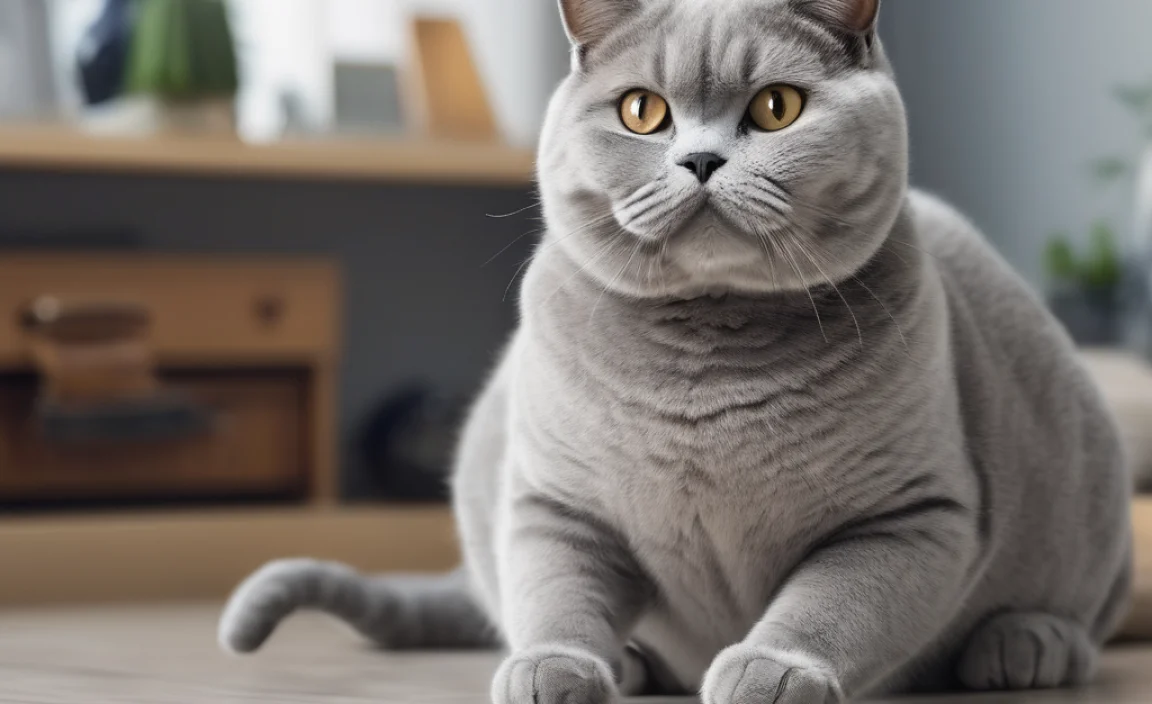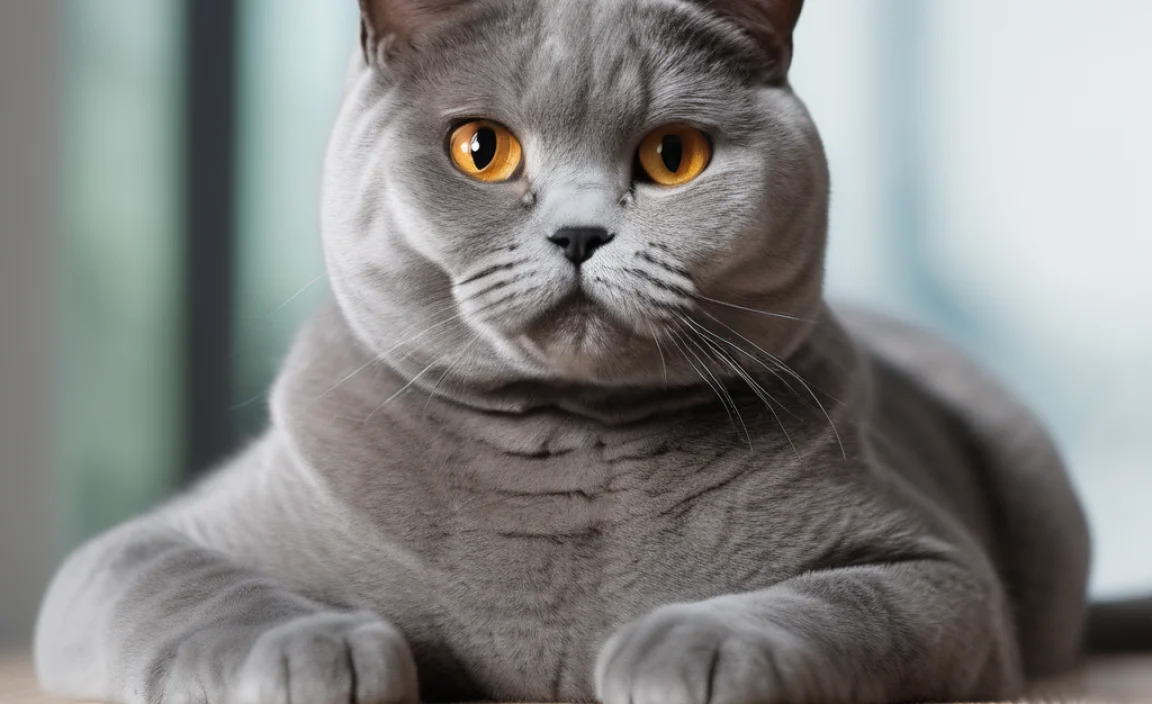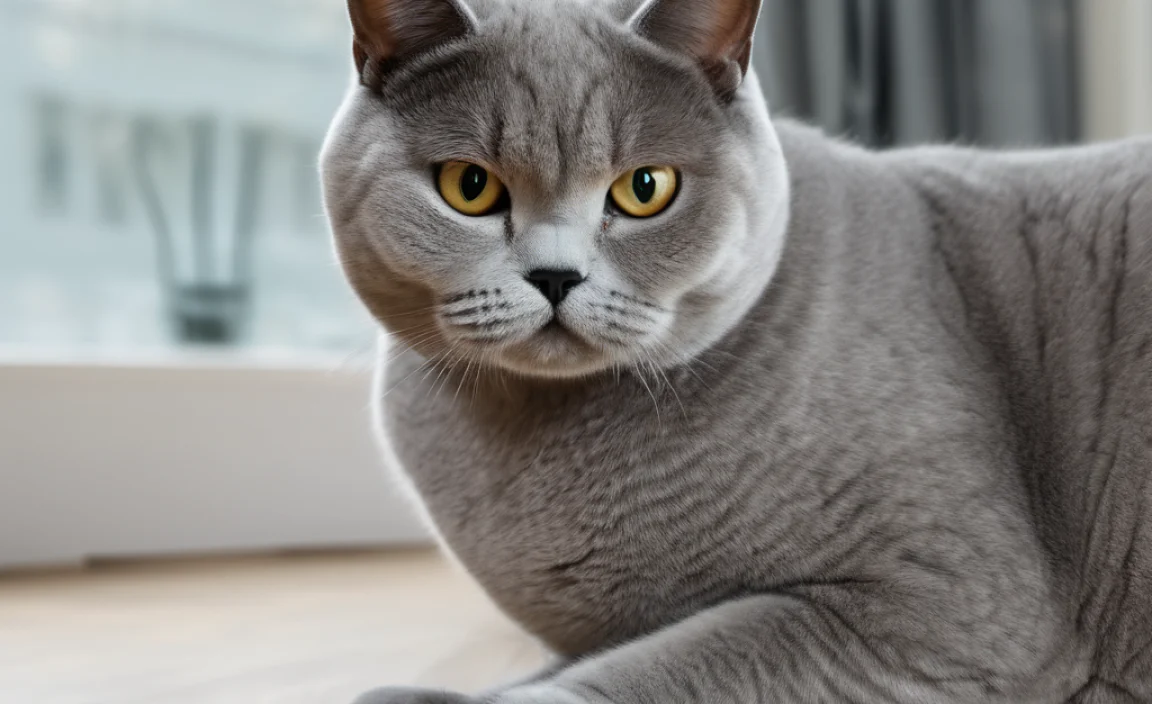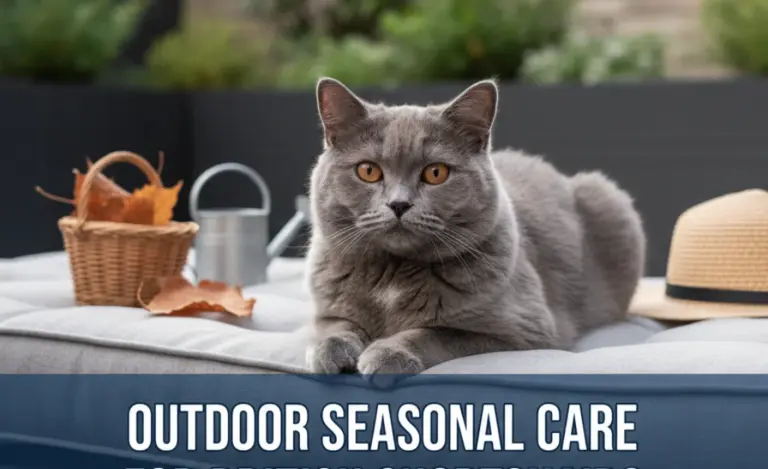Smart Indoor Activity Monitoring for British Shorthairs
Quick Summary: Keeping track of your British Shorthair’s activity levels indoors is easier than you think! By using simple tools like activity monitors, strategically placed toys, interactive feeders, and regular playtime, you can ensure your feline friend stays happy, healthy, and engaged. Monitoring their activity helps spot changes early, which could signal health issues, and allows you to adjust their environment for optimal well-being.
Worried about whether your British Shorthair is getting enough exercise indoors? It’s a common concern for cat owners, especially with this breed known for its relaxed demeanor. Are they sleeping too much? Playing too little? It can be tricky to tell! The good news is, there are simple, effective ways to monitor their activity and ensure they’re living their best, most active lives. We’ll walk you through easy-to-use tools and techniques to keep a close eye on your furry companion’s indoor adventures.
Why Monitor Your British Shorthair’s Indoor Activity?

As a devoted British Shorthair owner, you want the best for your feline friend. Monitoring their indoor activity isn’t just about curiosity; it’s a key part of responsible pet ownership. Here’s why it’s so important:
- Early Detection of Health Issues: Changes in activity levels can be an early warning sign of health problems. A sudden decrease in playfulness or reluctance to move could indicate arthritis, dental pain, or other underlying conditions. According to the Cornell Feline Health Center, recognizing subtle changes in behavior is crucial for early diagnosis and treatment.
- Preventing Obesity: British Shorthairs are prone to weight gain, especially as they get older. Monitoring their activity helps you balance their calorie intake with their energy expenditure, preventing obesity and related health issues like diabetes.
- Ensuring Mental Well-being: A bored cat is an unhappy cat. Monitoring activity helps you identify periods of inactivity and boredom, allowing you to provide more enrichment and stimulation.
- Understanding Behavior Patterns: By tracking your cat’s activity, you can learn about their natural rhythms and preferences. This knowledge can help you create a more enriching and comfortable environment for them.
Tools and Techniques for Indoor Activity Monitoring

There are several ways to monitor your British Shorthair’s activity indoors, ranging from high-tech gadgets to simple observation. Let’s explore some of the most effective methods:
1. Activity Monitors for Cats
Activity monitors are wearable devices that track your cat’s movements throughout the day. They provide valuable data on their activity levels, sleep patterns, and even calorie expenditure. Here’s what you need to know:
- How They Work: These small, lightweight devices attach to your cat’s collar and use sensors to detect motion. They transmit data to a smartphone app or computer, where you can view detailed reports.
- Benefits:
- Objective data on activity levels
- Tracking of sleep patterns
- Early detection of changes in behavior
- Motivation to increase your cat’s activity
- Popular Options:
- FitBark 2: A popular choice known for its durability and accurate tracking. It monitors activity levels and sleep quality.
- Whistle GO Explore: This GPS-enabled tracker not only monitors activity but also provides location tracking, which is useful if your cat likes to explore outdoors.
- Tractive GPS Cat Tracker: Another GPS option that also tracks activity and sleep, with a focus on real-time location tracking.
- Things to Consider:
- Comfort: Choose a lightweight and comfortable monitor that won’t bother your cat.
- Battery Life: Look for a monitor with a long battery life so you don’t have to charge it frequently.
- Water Resistance: A water-resistant monitor is a good idea, especially if your cat enjoys playing with water.
- Data Accuracy: Read reviews to ensure the monitor provides accurate and reliable data.
2. Interactive Toys and Games
Interactive toys are a fantastic way to encourage your British Shorthair to move and play. They stimulate their natural hunting instincts and provide mental enrichment. Here are some ideas:
- Puzzle Feeders: These toys require your cat to solve a puzzle to access their food, encouraging them to be active and engaged during meal times.
- Laser Pointers: A classic cat toy that gets them chasing a beam of light. Just be sure to end the session by letting them “catch” a physical toy to avoid frustration.
- Fishing Pole Toys: These toys mimic the movement of prey, enticing your cat to pounce and chase.
- Catnip Toys: Many cats are attracted to catnip, which can stimulate playfulness and activity.
- Automated Toys: Battery-operated toys that move and interact with your cat on their own, providing entertainment even when you’re not available.
3. Creating an Engaging Indoor Environment
The environment in which your British Shorthair lives plays a significant role in their activity levels. A stimulating and enriching environment will naturally encourage them to move and explore.
- Cat Trees and Shelves: These provide vertical space for your cat to climb, jump, and observe their surroundings.
- Window Perches: Cats love to watch the world outside. A window perch gives them a comfortable spot to observe birds, squirrels, and other interesting sights.
- Scratching Posts: Scratching is a natural behavior for cats, and providing scratching posts allows them to exercise their muscles and keep their claws healthy.
- Hiding Places: Cats need safe and secure places to retreat to when they feel stressed or overwhelmed. Provide boxes, tunnels, or covered beds where they can hide.
- Rotate Toys Regularly: Keep your cat interested by rotating their toys every few days. This will prevent boredom and encourage them to play with “new” toys.
4. Scheduled Playtime
Dedicated playtime is essential for keeping your British Shorthair active and engaged. Aim for at least 15-20 minutes of interactive play each day. Here are some tips:
- Choose the Right Time: Observe your cat’s natural rhythms and choose a time when they are most active and playful.
- Use a Variety of Toys: Offer a mix of toys to keep them interested and engaged.
- Mimic Hunting Behavior: Move the toys in a way that mimics the movement of prey, enticing them to chase, pounce, and capture.
- End on a High Note: Finish the playtime session with a rewarding activity, such as a treat or a cuddle.
5. Observation and Record Keeping
Sometimes, the simplest method is the most effective. Regular observation of your British Shorthair’s behavior can provide valuable insights into their activity levels. Keep a record of your observations to track any changes over time.
- Daily Activity Log: Create a simple log to record your cat’s daily activities, such as playtime, feeding, sleeping, and grooming.
- Note Any Changes: Pay attention to any changes in their behavior, such as decreased appetite, increased sleeping, or reluctance to move.
- Consult Your Veterinarian: If you notice any concerning changes, consult your veterinarian. They can help you determine if there is an underlying health issue.
Practical Tips for British Shorthairs

British Shorthairs, while not the most energetic breed, still need regular activity to stay healthy. Here are some breed-specific tips:
- Encourage Climbing: While they may not be as agile as some other breeds, British Shorthairs still enjoy climbing. Provide sturdy cat trees or shelves that they can easily access.
- Focus on Short, Frequent Play Sessions: British Shorthairs tend to have shorter bursts of energy. Opt for several short play sessions throughout the day rather than one long session.
- Be Patient: Don’t force your cat to play if they’re not in the mood. Be patient and wait for them to initiate playtime.
- Consider Their Age: Kittens will naturally be more active than senior cats. Adjust your expectations and activities accordingly.
- Provide Comfortable Resting Spots: After a play session, ensure your British Shorthair has a comfortable and quiet place to rest and recover.
Example Activity Monitoring Schedule

Here’s a sample schedule to help you integrate activity monitoring into your daily routine:
| Time | Activity | Purpose |
|---|---|---|
| 7:00 AM | Observe behavior during feeding | Check appetite and mobility |
| 8:00 AM | 15-minute play session with fishing pole toy | Encourage physical activity |
| 12:00 PM | Check activity monitor data | Track morning activity levels |
| 5:00 PM | Puzzle feeder for dinner | Mental stimulation and slower eating |
| 7:00 PM | 10-minute play session with laser pointer | Encourage chasing and pouncing |
| 10:00 PM | Observe behavior before bedtime | Check for any signs of discomfort or illness |
Addressing Common Concerns

Monitoring your British Shorthair’s activity can bring up some questions. Let’s address some common concerns:
- My cat seems lazy. Is this normal? British Shorthairs are known for their relaxed nature, but it’s important to distinguish between normal laziness and lethargy caused by a health issue. If you’re concerned, consult your veterinarian.
- My cat hates wearing a collar. How can I use an activity monitor? Introduce the collar gradually, starting with short periods and rewarding them with treats. You can also try a harness instead of a collar.
- How do I interpret the data from an activity monitor? Most activity monitors provide guidelines for interpreting the data. Look for trends and changes over time, rather than focusing on specific numbers.
- My cat only plays when I’m around. How can I encourage them to be active when I’m not home? Provide a stimulating environment with interactive toys and rotate them regularly. You can also consider getting a companion cat to provide social interaction and play.
Understanding Activity Levels By Age
A British Shorthair’s activity levels naturally change as they age. Here’s a general overview of what to expect at different life stages:
| Life Stage | Typical Activity Level | Considerations |
|---|---|---|
| Kitten (0-1 year) | Very high | Kittens are naturally curious and playful. Provide plenty of opportunities for exploration and play. |
| Young Adult (1-3 years) | High to moderate | Activity levels may start to decrease as they mature. Continue to provide regular playtime and enrichment. |
| Mature Adult (3-7 years) | Moderate | Activity levels may stabilize. Monitor their weight and adjust their diet and exercise accordingly. |
| Senior (7+ years) | Low | Activity levels will likely decrease significantly. Provide comfortable resting spots and gentle playtime. Consult your veterinarian about age-related health concerns. |
The Importance of Regular Vet Checks
While indoor activity monitoring can provide valuable insights into your British Shorthair’s health, it’s not a substitute for regular veterinary checkups. Annual or bi-annual visits to the vet are essential for detecting and preventing health problems. The RSPCA emphasizes the importance of preventative care for cats, including vaccinations, parasite control, and dental care.
FAQ: Indoor Activity Monitoring for British Shorthairs
Here are some frequently asked questions about monitoring your British Shorthair’s indoor activity:
1. Why is my British Shorthair so lazy?
British Shorthairs are known for their calm and relaxed nature, often enjoying lounging around. However, it’s important to ensure this isn’t due to underlying health issues. Regular vet check-ups and monitoring for changes in behavior are crucial.
2. What are the best toys to encourage activity?
Interactive toys like puzzle feeders, laser pointers (used responsibly), and fishing pole toys work well. Rotate toys regularly to keep your cat interested and engaged.
3. How much playtime does my British Shorthair need?
Aim for at least 15-20 minutes of interactive play each day, broken into shorter sessions. Observe your cat’s energy levels and adjust the duration accordingly.
4. Can an activity monitor really help?
Yes! Activity monitors provide objective data on your cat’s activity levels and sleep patterns. This can help you identify changes that might indicate health problems.
5. How can I create a more stimulating indoor environment?
Provide cat trees, window perches, scratching posts, and hiding places. Ensure they have access to sunny spots and plenty of toys to keep them entertained.
6. What are the signs of a healthy, active British Shorthair?
A healthy British Shorthair will have a good appetite, maintain a healthy weight, groom themselves regularly, and engage in playful behavior. They should also be alert and responsive.
7. Is it normal for older cats to be less active?
Yes, it’s normal for older cats to be less active. However, it’s still important to encourage gentle exercise and provide a comfortable environment. Consult your vet for advice on managing age-related health issues.
Conclusion
Monitoring your British Shorthair’s indoor activity is a simple yet powerful way to ensure their health and well-being. By using a combination of activity monitors, interactive toys, environmental enrichment, and regular playtime, you can keep your feline friend happy, healthy, and engaged. Remember to observe their behavior closely and consult your veterinarian if you have any concerns. With a little effort, you can create an indoor environment that encourages activity and provides your British Shorthair with the best possible quality of life. After all, a happy cat makes for a happy home!



